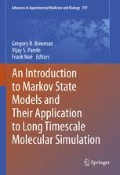Abstract
Molecular recognition, the process by which biological macromolecules selectively bind, plays an important role in many biological processes. Molecular simulations hold great potential to reveal the chemical details of molecular recognition and to complement experiments. However, it is challenging to reconstruct the binding process for two-body systems like protein-ligand complexes because the system’s dynamics occurs on significantly different timescales due to several physical processes involved, such as diffusion, local interactions and conformational changes. In this chapter, we review some recent progress on applying Markov state models (MSMs) to two-body systems. Emphasis is placed on the value of projecting dynamics onto collective reaction coordinates and treating the ligand dynamics with different resolution models depending on the proximity of the protein and ligand. We also discuss some future directions on constructing MSMs to investigate molecular recognition processes.
Access this chapter
Tax calculation will be finalised at checkout
Purchases are for personal use only
References
Koshland DE (1958) Application of a theory of enzyme specificity to protein synthesis. Proc Natl Acad Sci USA 44(2):98–104
Kumar S, Ma B, Tsai CJ, Sinha N, Nussinov R (2000) Folding and binding cascades: dynamic landscapes and population shifts. Protein Sci 9(1):10–19
Ma B, Kumar S, Tsai CJ, Nussinov R (1999) Folding funnels and binding mechanisms. Protein Eng 12(9):713–720
Ma B, Shatsky M, Wolfson HJ, Nussinov R (2002) Multiple diverse ligands binding at a single protein site: a matter of pre-existing populations. Protein Sci 11(2):184–197
Tsai CJ, Kumar S, Ma B, Nussinov R (1999) Folding funnels, binding funnels, and protein function. Protein Sci 8(6):1181–1190
Tsai CJ, Ma B, Nussinov R (1999) Folding and binding cascades: shifts in energy landscapes. Proc Natl Acad Sci USA 96(18):9970–9972
Arora K, Brooks CL (2007) Large-scale allosteric conformational transitions of adenylate kinase appear to involve a population-shift mechanism. Proc Natl Acad Sci USA 104(47):18496–18501
Bahar I, Chennubhotla C, Tobi D (2007) Intrinsic dynamics of enzymes in the unbound state and relation to allosteric regulation. Curr Opin Struct Biol 17(6):633–640
Oh BH, Ames GF, Kim SH (1994) Structural basis for multiple ligand specificity of the periplasmic lysine-, arginine-, ornithine-binding protein. J Biol Chem 269(42):26323–26330
Ames GF (1986) Bacterial periplasmic transport systems: structure, mechanism, and evolution. Annu Rev Biochem 55:397–425
Pang A, Arinaminpathy Y, Sansom MS, Biggin PC (2005) Comparative molecular dynamics-similar folds and similar motions? Proteins 61(4):809–822
Stockner T, Vogel H, Tieleman D (2005) A salt-bridge motif involved in ligand binding and large-scale domain motions of the maltose-binding protein. Biophys J 89(5):3362–3371
Buchete NV, Hummer G (2008) Coarse master equations for peptide folding dynamics. J Phys Chem B 112(19):6057–6069
Noe F, Schutte C, Vanden-Eijnden E, Reich L, Weikl TR (2009) Constructing the equilibrium ensemble of folding pathways from short off-equilibrium simulations. Proc Natl Acad Sci USA 106(45):19011–19016
Huang X, Yao Y, Bowman GR, Sun J, Guibas LJ, Carlsson G, Pande VS (2010) Constructing multi-resolution markov state models (msms) to elucidate RNA hairpin folding mechanisms. Pac Symp Biocomput, 228–239
Voelz VA, Bowman GR, Beauchamp K, Pande VS. Molecular simulation of ab initio protein folding for a millisecond folder NTL9(1-39). J Am Chem Soc 132(5):1526–1528
Morcos F, Chatterjee S, McClendon CL, Brenner PR, Lopez-Rendon R, Zintsmaster J, Ercsey-Ravasz M, Sweet CR, Jacobson MP, Peng JW, Izaguirre JA (2010) Modeling conformational ensembles of slow functional motions in Pin1-WW. PLoS Comput Biol 6(12):e1001015
Buch I, Sadiq SK, De Fabritiis G (2011) Optimized potential of mean force calculations for standard binding free energies. J Chem Theory Comput 7(6):1765–1772
Buch I, Giorgino T, De Fabritiis G (2011) Complete reconstruction of an enzyme-inhibitor binding process by molecular dynamics simulations. Proc Natl Acad Sci USA 108(25):10184–10189
Bowman GR, Huang X, Pande VS (2009) Using generalized ensemble simulations and Markov state models to identify conformational states. Methods 49(2):197–201
Huang X, Bowman GR, Bacallado S, Pande VS (2009) Rapid equilibrium sampling initiated from nonequilibrium data. Proc Natl Acad Sci USA 106(47):19765–19769
Oh BH, Pandit J, Kang CH, Nikaido K, Gokcen S, Ames GF, Kim SH (1993) Three-dimensional structures of the periplasmic lysine/arginine/ornithine-binding protein with and without a ligand. J Biol Chem 268(15):11348–11355
Harvey MJ, Giupponi G, De Fabritiis G (2009) ACEMD: accelerating biomolecular dynamics in the microsecond time scale. J Chem Theory Comput 5(6):1632–1639
Buch I, Harvey MJ, Giorgino T, Anderson DP, De Fabritiis G (2010) High-throughput all-atom molecular dynamics simulations using distributed computing. J Chem Inf Model 50(3):397–403
Bucher D, Grant BJ, Markwick PR, McCammon JA (2011) Accessing a hidden conformation of the maltose binding protein using accelerated molecular dynamics. PLoS Comput Biol 7(4):e1002034
Quiocho FA, Ledvina PS (1996) Atomic structure and specificity of bacterial periplasmic receptors for active transport and chemotaxis: variation of common themes. Mol Microbiol 20(1):17–25
Tang C, Schwieters CD, Clore GM (2007) Open-to-closed transition in apo maltose-binding protein observed by paramagnetic NMR. Nature 449(7165):1078–1082
Author information
Authors and Affiliations
Corresponding author
Editor information
Editors and Affiliations
Rights and permissions
Copyright information
© 2014 Springer Science+Business Media Dordrecht
About this chapter
Cite this chapter
Huang, X., De Fabritiis, G. (2014). Understanding Molecular Recognition by Kinetic Network Models Constructed from Molecular Dynamics Simulations. In: Bowman, G., Pande, V., Noé, F. (eds) An Introduction to Markov State Models and Their Application to Long Timescale Molecular Simulation. Advances in Experimental Medicine and Biology, vol 797. Springer, Dordrecht. https://doi.org/10.1007/978-94-007-7606-7_9
Download citation
DOI: https://doi.org/10.1007/978-94-007-7606-7_9
Publisher Name: Springer, Dordrecht
Print ISBN: 978-94-007-7605-0
Online ISBN: 978-94-007-7606-7
eBook Packages: Biomedical and Life SciencesBiomedical and Life Sciences (R0)

